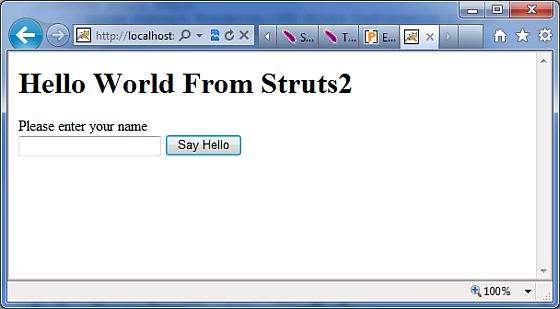- Struts 2 OGNL教程
- Struts 2 OGNL教程(1)
- Struts 2配置文件-struts.xml
- Struts 2配置文件-struts.xml(1)
- Struts 2教程(1)
- Struts 2教程
- 讨论Struts 2(1)
- 讨论Struts 2
- c++中的堆栈(1)
- C#|堆栈类(1)
- C#堆栈(1)
- 堆栈 c++ (1)
- 堆栈之和 c++ (1)
- 本机堆栈与堆栈 (1)
- 堆栈 (1)
- C#|堆栈类
- C#堆栈
- Struts 2-概述(1)
- Struts 2-概述
- Struts 2-注释(1)
- Struts 2-注释
- struts 2注释示例
- struts 2注释示例(1)
- Java的Spring 与 Struts(1)
- Java的Spring 与 Struts
- Struts 2-数据标签
- Struts 2-数据标签(1)
- 本机堆栈与堆栈 - Javascript 代码示例
- 本机堆栈与堆栈 - 任何代码示例
📅 最后修改于: 2020-11-11 04:58:39 🧑 作者: Mango
价值栈
值堆栈是几个对象的集合,这些对象按提供的顺序保持以下对象:
| Sr.No | Objects & Description |
|---|---|
| 1 |
Temporary Objects There are various temporary objects which are created during execution of a page. For example the current iteration value for a collection being looped over in a JSP tag. |
| 2 |
The Model Object If you are using model objects in your struts application, the current model object is placed before the action on the value stack. |
| 3 |
The Action Object This will be the current action object which is being executed. |
| 4 |
Named Objects These objects include #application, #session, #request, #attr and #parameters and refer to the corresponding servlet scopes. |
可以通过为JSP,Velocity或Freemarker提供的标签访问值堆栈。我们将在单独的章节中研究各种标签,这些标签用于获取和设置struts 2.0值堆栈。您可以在操作内获取valueStack对象,如下所示:
ActionContext.getContext().getValueStack()
一旦有了ValueStack对象,就可以使用以下方法来操作该对象-
| Sr.No | ValueStack Methods & Description |
|---|---|
| 1 |
Object findValue(String expr) Find a value by evaluating the given expression against the stack in the default search order. |
| 2 |
CompoundRoot getRoot() Get the CompoundRoot which holds the objects pushed onto the stack. |
| 3 |
Object peek() Get the object on the top of the stack without changing the stack. |
| 4 |
Object pop() Get the object on the top of the stack and remove it from the stack. |
| 5 | void push(Object o)
Put this object onto the top of the stack. |
| 6 |
void set(String key, Object o) Sets an object on the stack with the given key so it is retrievable by findValue(key,…) |
| 7 |
void setDefaultType(Class defaultType) Sets the default type to convert to if no type is provided when getting a value. |
| 8 |
void setValue(String expr, Object value) Attempts to set a property on a bean in the stack with the given expression using the default search order. |
| 9 |
int size() Get the number of objects in the stack. |
OGNL
对象图导航语言(OGNL)是一种功能强大的表达语言,用于引用和操纵ValueStack上的数据。 OGNL还有助于数据传输和类型转换。
OGNL与JSP表达语言非常相似。 OGNL基于在上下文中具有根对象或默认对象的思想。可以使用标记符号(即英镑符号)来引用默认对象或根对象的属性。
如前所述,OGNL基于上下文,Struts构建一个ActionContext映射以与OGNL一起使用。 ActionContext映射包含以下内容-
-
应用程序-应用程序范围变量
-
会话-会话范围变量
-
根/值堆栈-所有操作变量都存储在此处
-
请求-请求范围变量
-
参数-请求参数
-
Atributes -存储在页,请求,会话和应用范围的属性
重要的是要了解Action对象在值堆栈中始终可用。因此,因此,如果您的操作对象具有属性“ x”和“ y”,则可以轻松使用。
使用磅符号来引用ActionContext中的对象,但是,可以直接引用值堆栈中的对象。
例如,如果employee是动作类的属性,则可以如下引用它:
代替
如果您在会话中有一个名为“登录”的属性,则可以按以下方式检索它:
OGNL还支持处理集合-即Map,List和Set。例如,要显示颜色的下拉列表,可以执行以下操作:
OGNL表达式很聪明,可以将“红色”,“黄色”,“绿色”解释为颜色,并以此为基础构建列表。
当我们研究不同的标签时,OGNL表达式将在下一章中广泛使用。因此,与其孤立地查看它们,不如让我们使用“表单标签/控件标签/数据标签和Ajax标签”部分中的一些示例进行查看。
ValueStack / OGNL示例
建立动作
让我们考虑以下操作类,在其中访问valueStack,然后设置一些键,这些键将在视图(即JSP页面)中使用OGNL进行访问。
package com.tutorialspoint.struts2;
import java.util.*;
import com.opensymphony.xwork2.util.ValueStack;
import com.opensymphony.xwork2.ActionContext;
import com.opensymphony.xwork2.ActionSupport;
public class HelloWorldAction extends ActionSupport {
private String name;
public String execute() throws Exception {
ValueStack stack = ActionContext.getContext().getValueStack();
Map context = new HashMap();
context.put("key1", new String("This is key1"));
context.put("key2", new String("This is key2"));
stack.push(context);
System.out.println("Size of the valueStack: " + stack.size());
return "success";
}
public String getName() {
return name;
}
public void setName(String name) {
this.name = name;
}
}
实际上,Struts 2在执行时会将您的操作添加到valueStack的顶部。因此,将东西放入值堆栈的通常方法是将值的获取器/设置器添加到Action类,然后使用
创建视图
让我们在Eclipse项目的WebContent文件夹中创建以下jsp文件HelloWorld.jsp 。如果操作返回成功,将显示此视图-
Hello World
Entered value :
Value of key 1 :
Value of key 2 :
我们还需要在WebContent文件夹中创建index.jsp ,其内容如下-
Hello World
Hello World From Struts2
配置文件
以下是struts.xml文件的内容-
/HelloWorld.jsp
以下是web.xml文件的内容-
Struts 2
index.jsp
struts2
org.apache.struts2.dispatcher.FilterDispatcher
struts2
/*
右键单击项目名称,然后单击导出> WAR文件以创建War文件。然后,将此WAR部署在Tomcat的webapps目录中。
最后,启动Tomcat服务器并尝试访问URL http:// localhost:8080 / HelloWorldStruts2 / index.jsp 。这将产生以下屏幕

现在,在给定的文本框中输入任何单词,然后单击“说声你好”按钮以执行定义的操作。现在,如果您要检查生成的日志,则会在底部找到以下文本:
Size of the valueStack: 3
这将显示以下屏幕,该屏幕将显示您输入的任何值以及我们放在ValueStack上的key1和key2的值。